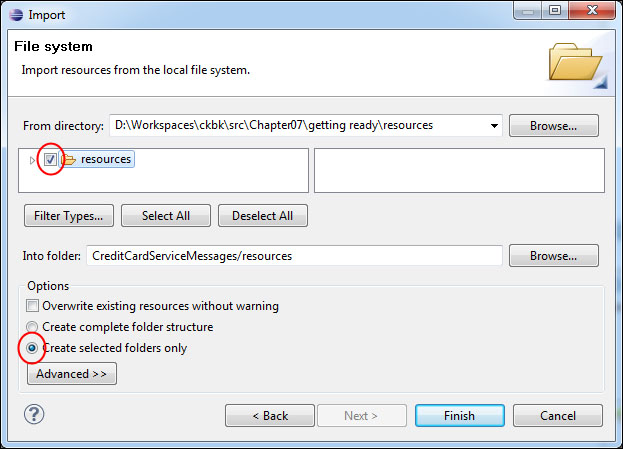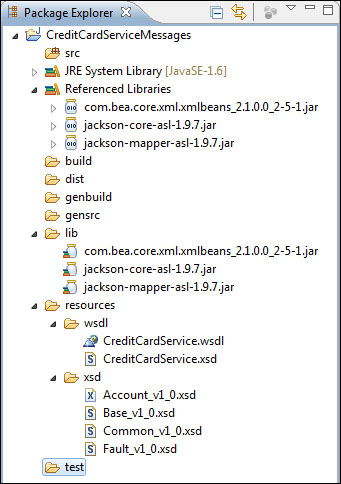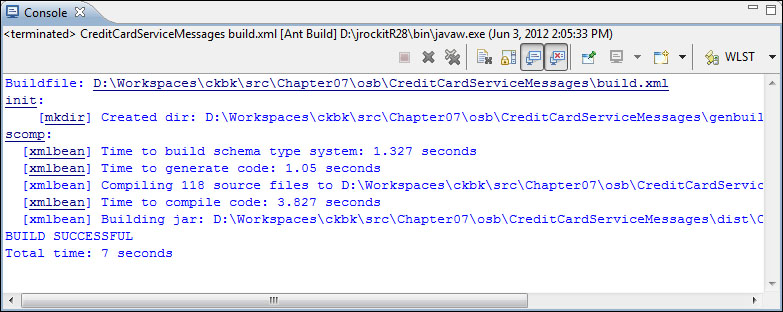Since JSON formatted data is likely to be needed only when communicating with a partner system, we'll assume that it's most common to convert between XML and JSON in Oracle Service Bus. For working with XML, we'll use XMLBeans, as that's what OSB uses. For parsing and generating JSON, we'll use Jackson (Version 1.9.x).
This recipe assumes the use of an existing OSB configuration project within the OSB workshop for development. So, ensure that you have installed and familiarized yourself with it prior to beginning.
If you wish to follow along exactly with these instructions you will require a copy of the schema and WSDL files used in this recipe. Copies of these are included with the code samples for the book.
Oracle Service Bus uses XMLBeans to provide its XML/object mapping. We'll use the same library to make our task simpler.
In order to map between JSON and objects, we'll use the Jackson library. Download Version 1.9.x of the Jackson Core ASL and Mapper ASL libraries from http://wiki.fasterxml.com/JacksonDownload.
- From the context menu in the Package Explorer view, select New | Java Project. For this example, the project is named
CreditCardServiceMessages. Keep the remaining defaults and click on Next. - For the Java Settings, set the Default output folder to
CreditCardServiceMessages/build/classes. Click on Finish. - For setting up the project structure, select CreditCardServiceMessages within the Package Explorer view, right-click and select New | Folder. Name the folder
distand click on OK. - Repeat this process to create the folders
genbuild,gensrc,lib,resources, andtestin the Java project.Next, we need to import the schema and WSDL files we are using for this example.
- Within the Package Explorer view, select resources, right-click and select Import. This will open the Import Wizard. Select General | File System as the source and click on Next.
- Browse to the file directory containing the code samples for this chapter, and within the directory
getting ready, select the folderresources. - Within the Import window, ensure resources is checked and the option Create selected folder structure is selected (as circled in the following screenshot) and click on Finish.

- To import the JAR files, select lib within the Package Explorer view, right-click and select Import. In the Import wizard, select General | File system, and click on Next.
- Browse to the directory
<MIDDLEWARE_HOME>/osb/modules - Click on OK and select the file
com.bea.core.xml.xmlbeans_2.1.0.0_2-5-1.jarand click on Finish. This will create a copy of the JAR file in thelibfolder within the Java project. - Repeat this step to import the
jackson-core-asl-1.9.x.jarandjackson-mapper-asl-1.9.x.jarlibraries. Add the libraries to the projects build path by selecting the three files, right-clicking, and selecting Build Path | Add to Build Path.The structure of our Java Project should resemble the following screenshot:

- We'll use Ant to build our project. Within the Package Explorer view, select CreditCardServiceMessages, right-click and select Import. This will open the Import Wizard. Select General | File System as the source and click on Next.
- Browse to the file directory containing the code samples for this chapter and select the folder
getting ready. Within the Import window, ensure build.xml is checked and click on Finish.The most important target to note at this point within the
build.xmlfile isscomp.<taskdef name="xmlbean" classname="org.apache.xmlbeans.impl.tool.XMLBean" classpath="${lib}/com.bea.core.xml.xmlbeans_2.1.0.0_2-5-1.jar" /> <!-- Compile the config schema definition with XmlBeans --> <target name="scomp" depends="init" description="compile xsd"> <xmlbean srcgendir="${gensrc}" classgendir="${genbuild}" destfile="${dist}/${ant.project.name}XmlBeans_1.0.jar" failonerror="true" classpathref="project.class.path"> <fileset dir="${schemadir}" includes="wsdl/CreditCardService.xsd" /> </xmlbean> </target>This compiles the schemas we have imported using XmlBeans, and will be required for subsequent steps.
- To compile the schemas, select Window | Show View | Ant and open the Ant View in our Eclipse perspective; next drag the
build.xmlfile into the Ant View, and double-click on thescomptarget.This will run the
scomptarget, which will use xmlbeans to generate Java classes which represent the schema types in our imported schemas and package them into the JAR file, namedCreditCardServiceMessagesXmlBeans_1.0.jar.You should see output similar to the following, in the Console view:

The generated JAR file will be placed in the
distdirectory (refresh the project structure view if you can't see it). - Right-click on this file, and select Build Path | Add to Build Path from the context menu, as we'll be writing classes that depend on this library later.
- Next, we need to create Plain Old Java Objects (POJOs) that represent the JSON objects that we will later be exchanging. These classes have no knowledge of the Jackson libraries that we will be using to convert between the object and JSON representations.
For our example we will create the following classes:
CreditCardDebitCreditCardDebitCreditCardResponse
An excerpt from the
CreditCardclass is shown as follows:package com.rubiconred.ckbk.creditcardsvc.pojo; public class CreditCard { private String cardType; private String cardHolderName; private String cardNumber; private Integer expiryMonth; private Integer expiryYear; private String securityNo; public String getCardType() { return cardType; } public void setCardType(String cardType) { this.cardType = cardType; } public String getCardHolderName() { return cardHolderName; } // … }Note
Primitive types are not used for the previous numeric values. It is common for values in JSON objects to be optional, and either be omitted entirely from the serialised representation, or be serialised with a value of
null. Java's primitive types cannot represent the absence of a value, so the object types should in general be used for numeric. - Next we need to create the Java class
CreditCardServiceMapperFactorythat will be used to convert between the previous POJOs and their JSON representations.A snapshot of the code to do this is shown as follows. The full source code is provided in the sample for the chapter.
package com.rubiconred.ckbk.creditcardsvc.json; import … public class CreditCardServiceMapperFactory { private static ObjectMapper mapper; private static ObjectReader debitCreditCardReader; private static ObjectWriter debitCreditCardWriter; static { mapper = new ObjectMapper(); // Include null values in generated JSON mapper.setSerializationConfig(mapper.getSerializationConfig() .withSerializationInclusion(Inclusion.ALWAYS)); debitCreditCardReader = mapper.reader(DebitCreditCard.class); debitCreditCardWriter = mapper.writerWithType(DebitCreditCard.class); // … } public static ObjectReader getDebitCreditCardReader() { return debitCreditCardReader; } public static ObjectWriter getDebitCreditCardWriter() { return debitCreditCardWriter; } // … }Jackson makes this very straightforward. The
ObjectReaderandObjectWriterinstances that we create are immutable, so they're thread-safe and can be shared as required.The
ObjectMapperis the object on which the details of the JSON (de-) serialization are configured. For this example, we'll configure the mapper to includenullvalues, rather than omitting them.Now that we have the necessary scaffolding in place, we can write the code that will convert between the XML format (exposed as an XMLBeans
XmlObjectinstance) and the JSON format (represented by the POJOs we created earlier). This is the code that will later be invoked using Java Callout actions in OSB proxy services. - In order to convert from JSON to XML, we create a method that accepts the JSON in a String, and uses the appropriate
ObjectReaderto parse it into the POJO we created earlier.The fields of the POJO are used to populate a new instance of the appropriate
XmlObject. This is illustrated in the following method:public static XmlObject debitCreditCardJsonToXml(String json) { ObjectReader reader = CreditCardServiceMapperFactory .getDebitCreditCardReader(); DebitCreditCardDocument debitDoc = DebitCreditCardDocument .Factory.newInstance(); DebitCreditCard jsonDebitCreditCard; TDebitCreditCard xmlDebitCreditCard; TCreditCard xmlCreditCard; try { jsonDebitCreditCard = reader.readValue(json); CreditCard jsonCreditCard = jsonDebitCreditCard .getCreditCard(); xmlDebitCreditCard = TDebitCreditCard.Factory .newInstance(); xmlCreditCard = TCreditCard.Factory.newInstance(); xmlCreditCard.setCardHolderName(jsonCreditCard .getCardHolderName()); xmlCreditCard.setCardNumber(jsonCreditCard .getCardNumber()); xmlCreditCard.setCardType(jsonCreditCard .getCardType()); // Set Remainder of Credit Card Details… xmlDebitCreditCard.setCreditCard(xmlCreditCard); Double trnAmount =jsonDebitCreditCard.getTrnAmount(); if (trnAmount != null) { xmlDebitCreditCard.setTrnAmount( BigDecimal.valueOf(trnAmount)); } xmlDebitCreditCard.setTrnDesc(jsonDebitCreditCard .getTrnDesc()); debitDoc.setDebitCreditCard(xmlDebitCreditCard); } catch (JsonProcessingException e) { e.printStackTrace(); } catch (IOException e) { e.printStackTrace(); } return debitDoc; } - To convert from JSON to XML we simply use the following code fragment:
DebitCreditCardDocument doc; doc = (DebitCreditCardDocument) DebitCreditCardConverter .debitCreditCardJsonToXml(DEBIT_CREDIT_CARD_JSON_STRING); TDebitCreditCard debitCreditCard = doc.getDebitCreditCard();
Where
DEBIT_CREDIT_CARD_JSON_STRINGcontains the JSON to convert. The result of thisdebitCreditCardis an XMLBeans generated class that gives us a Java wrapper around the ML conversion ofdebitCreditCardwith JavaBeans-style accessors. - Converting from XML to JSON uses the same approach, starting from an
XmlObjectand producing aStringcontaining JSON, as illustrated in the following method:public static String debitCreditCardXmlToJson(XmlObject xml) { ObjectWriter writer = CreditCardServiceMapperFactory .getDebitCreditCardWriter(); DebitCreditCard debitCreditCard = new DebitCreditCard(); String json = null; DebitCreditCardDocument debitCreditCardDoc; TDebitCreditCard source = null; XmlObject doc = null; try { doc = XmlObject.Factory.parse(xml.newXMLStreamReader()); if (doc instanceof DebitCreditCardDocument) { debitCreditCardDoc = (DebitCreditCardDocument) doc; source = debitCreditCardDoc.getDebitCreditCard(); TCreditCard sourceCC = source.getCreditCard(); BigDecimal trnAmount = source.getTrnAmount(); if (trnAmount != null) { debitCreditCard.setTrnAmount(trnAmount .doubleValue()); } debitCreditCard.setTrnDesc(source.getTrnDesc()); CreditCard creditCard = new CreditCard(); creditCard.setCardHolderName(sourceCC .getCardHolderName()); creditCard.setCardNumber(sourceCC.getCardNumber()); creditCard.setCardType(sourceCC.getCardType()); creditCard.setExpiryMonth(sourceCC.getExpiryMonth()); creditCard.setExpiryYear(sourceCC.getExpiryYear()); creditCard.setSecurityNo(sourceCC.getSecurityNo()); debitCreditCard.setCreditCard(creditCard); json = writer.writeValueAsString(debitCreditCard); } else { System.out.println("debitCreditCardXmlToJson(): PARSE FAILED!!!"); } } catch (XmlException e) { e.printStackTrace(); } catch (JsonGenerationException e) { e.printStackTrace(); } catch (JsonMappingException e) { e.printStackTrace(); } catch (IOException e) { e.printStackTrace(); } return json; - To convert from XML to JSON we simply use the following code fragment:
XmlObject debitCreditCardXmlObject; debitCreditCardXmlObject = XmlObject.Factory .parse(DEBIT_CREDIT_CARD_XML); String json = DebitCreditCardConverter .debitCreditCardXmlToJson(debitCreditCardXmlObject);
Where
DEBIT_CREDIT_CARD_XMLcontains the XML to convert, the result of this JSON is a string containing the JSON representation of our XML object.Tip
It is important to keep in mind, when implementing these conversions, that some incoming values may be
null. One example of such an issue is when working with numeric values parsed from XML by XMLBeans; they will typically be instances ofBigDecimalorBigInteger. Should you want to assign these values to aDoubleorIntegerin your own objects, you must ensure that the returned value is notnullbefore invoking thedoubleValue()orintValue()methods.
Running the dist Ant task will produce a JAR file CreditCardServiceMessages_1.0.jar in the dist directory. This will be used later, along with the previously generated CreditCardServiceMessagesXmlBeans_1.0.jar, to perform the conversions between XML and JSON inside the OSB proxy services.
We use XMLBeans to parse and generate XML, and we use Jackson to parse and generate JSON. We then implement an adapter that takes care of the translation between the two representations.
It should be noted that there are other simpler frameworks which provide a mechanism for converting between XML and JSON, for example:
Given the simplicity of the previous example, any of these approaches would be fine. However, for more complex scenarios we find that Jackson provides the most control (it's also extremely fast – but that tends to be less relevant).
For example, Jackson provides many features for configuring the serialization and deserialization of your objects. In the event that the default behavior isn't appropriate for your use case, there are many options built-in, and custom (de-) serializers can be built very easily.
The final reason for leaning towards Jackson, is that it's leveraged by Coherence for its REST interface, so is a tried and tested component within the context of the Oracle stack.
